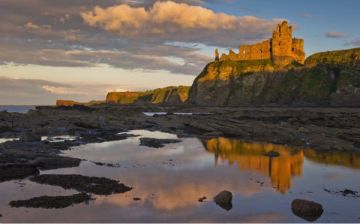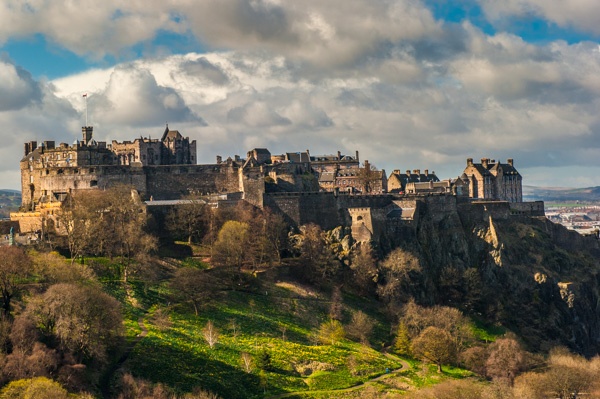
The city of Edinburgh can trace its history to at least the 7th century, when the Gododdin tribe established a hillfort on an outcrop of rock, probably the same hilltop now occupied by Edinburgh Castle. A settlement grew up beside the fort, and until the 10th century, the settlement formed part of the powerful Kingdom of Northumbria. St Cuthbert is said to have preached here in the 7th century.
History
From the mid-10th century, Edinburgh was generally under the control of the Scottish crown, and in AD 973 the English king Edgar the Peaceful granted Lothian to Kenneth II, King of the Scots. It was left to Malcolm II to finally subdue the Northumbrian threat in 1018. In 1130 David I established Edinburgh as a royal burgh, with the castle serving as a royal fortress. The king gave merchants a strip of land on the condition that they build a house on it within a year and a day.
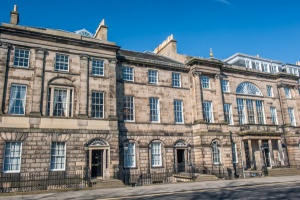
From these humble beginnings the city developed in importance and size. Edinburgh's growth was due in part to Berwick on Tweed's misfortune. Berwick was Scotland's major trading port until it was captured by England in the 1330s. With the port of Berwick closed to them, Scottish merchants used Edinburgh and the nearby port of Leith, and the city and port both prospered.
Edinburgh Castle
From its beginnings as a hillfort Edinburgh Castle became one of the most heavily fortified castles in Britain. It was used as a royal base in the early medieval period, and suffered several long sieges. The oldest building within the castle walls is a chapel built by David I in honour of his mother Queen Margaret, wife of Malcolm Canmore. The castle was captured by Edward I of England, then recaptured in a daring night raid by Scots under Sir Thomas Randolph.
James IV built the Great Hall in 1511, and the hall has served as a setting for meetings of Parliament and other ceremonial functions. The royal apartments date to the 15th century, and here you can see the small chamber where Mary, Queen of Scots gave birth to the future James VI and I. Another visitor highlight is the Honours of Scotland, including the regal Crown, Sceptre, and Sword of Scotland.
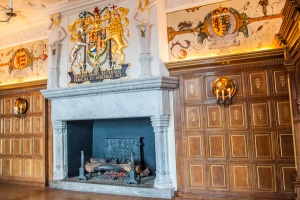
The story of Edinburgh is inextricably linked to the story of Mary, Queen of Scots and the Scottish Reformation. Reformer John Knox inflamed public opinion against Mary through his sermons at St Giles Cathedral. Mary's eventual imprisonment led to the 'Lang Siege' of Edinburgh Castle, defended by Mary's supporters.
The royalist supporters were overcome, but only after a long and bitter struggle. The religious divisions launched during Mary's reign led to the Wars of the Covenant and the eventual triumph of Presbyterianism in 1689.
The core of Edinburgh is divided into Old Town and New Town. Old Town was the historic centre of the city and is known for its narrow passages ('closes'). It is also replete with ghost stories, and you can take evening ghost walks from several points along the Royal Mile.
The Old Town area became overcrowded over time, and in the late 18th century wealthy citizens began to move to a new area of wide squares and elegant townhouses north of Princes Street. The contrast between the Old and New town areas is one of the most intriguing features of visiting Edinburgh.
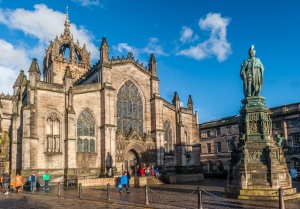
Royal Mile
The most famous byway in Scotland, the Royal Mile is not actually one street but several, linking Edinburgh Castle in the west to the Palace of Holyroodhouse in the east. Along the Royal Mile are historic buildings like Gladstone's Land, a 16th-century tenement built by a wealthy cloth merchant and new preserved by the National Trust for Scotland. Further west is St Giles Cathedral, the High Kirk of Edinburgh, begun in the 12th century.
The most famous episode in the long history of St Giles came in 1637 when the Dean tried to hold a service according to a new Anglican prayer book. According to legend, a street-seller named Jenny Geddes hurled her stool at the unfortunate Dean, launching a series of protests that eventually led to the National Covenant. The Covenant was signed at Greyfriar's Kirk, a short walk from the Royal Mile.
John Knox served as a minister at St Giles, and a short distance west of the Cathedral is John Knox's House, where he lived for the last few months of his life. The house itself predates Knox and was owned by a wealthy goldsmith. The interiors feature wonderfully carved panelling.
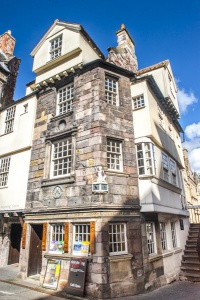
The most popular visitor attraction in elegant New Town is Georgian House in Charlotte Square, designed by Robert Adam in 1796 for John Lamont, chief of Clan Lamont. The house is preserved by the National Trust for Scotland and offers a fascinating glimpse into fashionable society in Edinburgh during the late 18th - early 19th century.
A short walk from Georgian House brings you to Princes Street, known for its fashionable shops. On the southern side of the avenue stand Princes Street Gardens, a beautiful public park dotted with historic monuments. At the eastern end of the gardens is the Scott Monument, built in 1840 to remember the author Sir Walter Scott. For a small fee, you can climb the 287 steps to an observation platform near the top for wonderful views over the Edinburgh cityscape and across the gardens to Edinburgh Castle.
Stately Homes and Castles
The historic house in the Edinburgh area is the Royal Palace of Holyroodhouse, at the western end of the Royal Mile. The Palace is the official residence of the monarch in Scotland, and is open to visitors when the monarch is not in residence.
You can see the state apartments, but the most popular part of the Palace is the suite of rooms occupied by Mary, Queen of Scots, including the chamber where her private secretary, David Rizzio, was murdered by her husband, Lord Darnley, and his followers. Beside the Palace stands the remains of Holyrood Abbey, founded by King David I in 1128 in gratitude for his escape from a hunting accident.
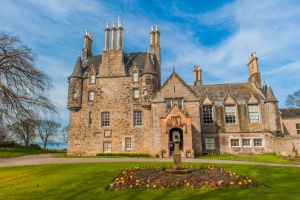
On the outskirts of Edinburgh stands Lauriston Castle, begun in 1593 and transformed into a country house in the early 19th century. The Castle is set in a historic garden designed by Sir William Playfair in the 1840s. On the south-eastern fringe of Edinburgh is Craigmillar Castle, a 15th-century tower house with strong links to Mary, Queen of Scots. Mary came to Craigmillar in 1566 to convalesce after Rizzio's death, and it was here that a plot was hatched, with or without her knowledge, to assassinate Lord Darnley.
Museums
Edinburgh is home to some of the finest and most popular museums in the country. Some, like the National Museum of Scotland and the Scottish National Gallery, host nationally important collections and welcome hundreds of thousands of visitors each year. Other museums are among Scotland's hidden treasures, tucked away off the main tourist routes.
One such is the Writers' Museum, housed in a 1622 house off the Royal Mile. The People's Story Museum in Canongate explores the heritage of Edinburgh through the daily lives of ordinary people from the 18th century to the present day.
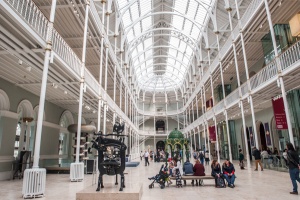
Greyfriar's Bobby
Of all the historic attractions in Edinburgh, there is one that stands out as a bit unusual. Outside the gates of Greyfriar's Kirkyard, at the junction of George IV Bridge and Candlemaker Row, stands a fountain topped by the statue of a Skye Terrier. The terrier is popularly known as Greyfriar's Bobby.
The dog was owned a city watchman named John Gray. When Gray died in 1858 he was buried in the Kirkyard. His faithful dog Bobby refused to be parted from his master, and for the next 14 years, he remained by his master's grave. When a new city bylaw came into force requiring all unlicensed dogs to be destroyed, Sir William Chambers, Lord Provost of Edinburgh, paid for Bobby's license and bought the dog a collar.
When Bobby finally died in 1872 he was buried in unconsecrated ground within the Kirkyard, and the collar was put on display at the Museum of Edinburgh.
Accommodation
As one of the most popular tourist destinations in Scotland, Edinburgh is well served with accommodation options. Just be aware that during the annual Edinburgh Festival in August that the city can be very busy and accommodation harder to find. Unless you are aiming to experience the Festival it might be better to plan a visit for other times of the year.
About Edinburgh
Address: Edinburgh,
Lothian,
Scotland
Attraction Type: Town
Website: Edinburgh
Location map
OS: NT252735
Photo Credit: David Ross and Britain Express
HERITAGE
 We've 'tagged' this attraction information to help you find related historic attractions and learn more about major time periods mentioned.
We've 'tagged' this attraction information to help you find related historic attractions and learn more about major time periods mentioned.
Historic Time Periods:
Find other attractions tagged with:
10th century (Time Period) - 12th century (Time Period) - 15th century (Time Period) - 16th century (Time Period) - 18th century (Time Period) - 19th century (Time Period) - 7th century (Time Period) - castle (Architecture) - Edward I (Person) - George IV (Person) - Georgian (Time Period) - Mary, Queen of Scots (Person) - Medieval (Time Period) - Reformation (Historical Reference) - Robert Adam (Person) - Royalist (Person) - tower house (Architecture) -
NEARBY HISTORIC ATTRACTIONS
Heritage Rated from 1- 5 (low to exceptional) on historic interest
Edinburgh Castle - 0 miles (Castle) ![]()
Scottish National Gallery - 0.2 miles (Museum) ![]()
Writer's Museum - 0.2 miles (Museum) ![]()
Gladstone's Land - 0.2 miles (Historic Building) ![]()
Greyfriars Kirk, Edinburgh - 0.3 miles (Historic Church) ![]()
St Giles Cathedral - 0.3 miles (Cathedral) ![]()
Scott Monument - 0.4 miles (Historic Building) ![]()
National Museum of Scotland - 0.4 miles (Museum) ![]()
Nearest Holiday Cottages to Edinburgh:
Edinburgh, Lothian
Sleeps: 5
Stay from: £512.00 - 2843.00
More self catering near Edinburgh








